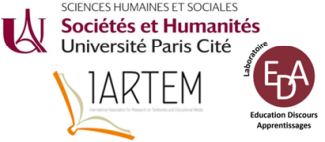Research problem and questions
Considering didactic transposition, the process of transforming academic knowledge into taught knowledge (Chevallard, 1985) occurs both when textbooks or other types of didactic devices, such as websites, are created. In the digital society, students and teachers increasingly turn to Internet 4.0, where they find educational websites. However, the knowledge transformations in question are not evident for the various agents of transposition, nor for teachers and students as users. Particularly in the area of teaching Special Relativity in high school and introductory college courses, great efforts are made to introduce basic notions of relativistic dynamics, but, for example, students still do not understand the meaning, the origin and usefulness of one of the most famous and socially disseminated equations of relativistic physics as E= mc2.
This work is part of a larger investigation, which aims to teach relativistic kinematics and dynamics in the last year of secondary school. In a previous work, we analyzed how textbooks used in high school and introductory university courses propose the central notions of relativistic dynamics (González, et. al., 2022). Here, we present a research whose objective is to analyze how the notions of relativistic dynamics are proposed in educational websites and the transformations that are made to knowledge. This work addresses the following research questions:
- What are the notions of relativistic dynamics proposed on websites for high school and introductory college courses, and what are their differences?
- What similarities and differences exist with respect to the knowledge that the textbooks propose for both levels?
- What are the implications for teaching the Theory of Special Relativity?
Methodology
From an exhaustive search on the Internet, 15 educational sites/web pages related to the teaching of relativistic dynamics were selected. The sites were analyzed using an inductive categorization, based on nominal variables and their respective modalities that arise from the considered corpus. As the analysis focuses on the transformations of knowledge, some of these variables coincide with those identified in the previous analysis focused on textbooks (González, et. al., 2022), allowing us to describe the similarities and differences between websites and the textbooks considered.
Data Analysis
16 nominal variables were identified that refer to three metacategories related to websites. The first is general characteristics such as the educational level they are aimed at, the type of resource, the institution of the authors, navigability, images, the use of simulations and videos. The second is the transformations of knowledge: the relationship with the treatment of knowledge carried out by websites, the “gateway” to relativistic dynamics, the foundation of the need to question and review classical dynamics to introduce relativistic dynamics, the role of the study of collisions, the importance attributed to experiments and the consequences of relativistic dynamics. The third is the reformulation of concepts like Momentum, Mass and Energy according to the Theory of Special Relativity.
Preliminary Results
The results show that websites developed by educational institutions adopt an approach similar to that of textbooks (González, et. al., 2022). This would be because traditionally academic knowledge is fundamentally based on certain canonical textbooks in physics. On the contrary, sites not linked to a specific institution deviate from the usual treatment of physics texts. In general, two major gateways to relativistic dynamics can be distinguished. In the secondary school-oriented sites, the classical concepts of Mass and Energy are introduced, questioning the validity of Newton's laws in the relativistic limit. Alternatively, sites aimed at university students predominantly use the notion of Momentum and the principles of conservation of Momentum and Energy. This result is similar to that obtained in the analysis of textbooks (ibid). Although the latter approach is epistemologically more solid, didactically it is not suitable for the secondary level because it requires previously studying the classic shocks that, although they are in the curriculum, are not taught.
Regardless of the educational level at which they are oriented, for the most part, the sites have few empirical references and applications such as nuclear reactions and nuclear energy. It is notable that only two secondary school sites propose simulations and only one university site uses videos, which may be a consequence of insufficient research in teaching relativistic dynamics.
References
Boublil, S., Blair, D., & Treagust, D.F. (2023). Design and Implementation of an Einsteinian Energy Learning Module. Int J of Sci and Math Educ. https://doi.org/10.1007/s10763-022-10348-
Chevallard, Y. (1985). La transposition didactique. Du savoir savant au savoir eneigné. Grenoble: La pensée Sauvage.
González, R., Otero, M. R., & Arlego, M. (2022). Análisis del enfoque de la dinámica relativista en los libros de texto de secundaria y la universidad. Revista de Enseñanza de la Física, 34, 211–219. Recovered from:https://revistas.unc.edu.ar/index.php/revistaEF/article/view/39833
Otero, M. R., Arlego, M., Prodanoff, F. (2016). Teaching the basic concepts of the Special Relativity in the secondary school in the framework of the Theory of Conceptual Fields of Vergnaud. Il Nuovo Cimento 38 C, DOI: 10.1393/ncc/i2015-15108-0.



